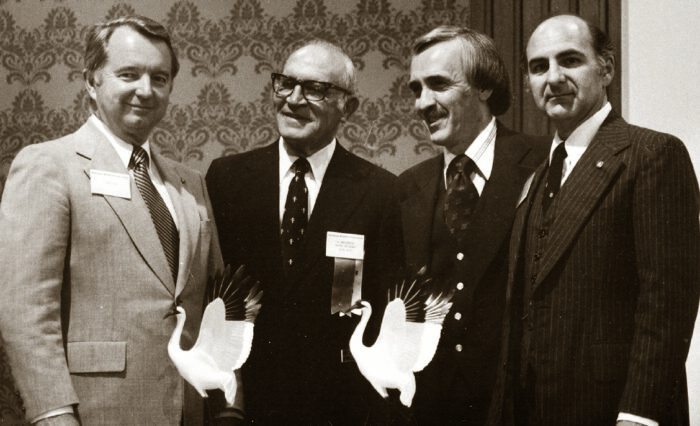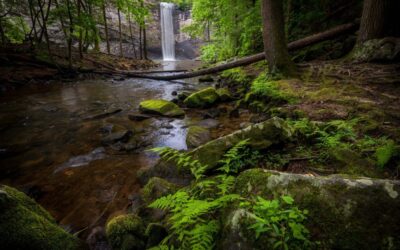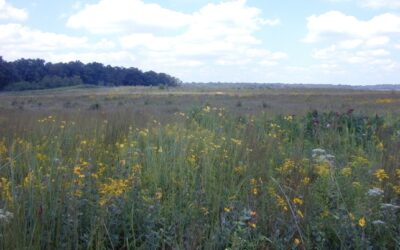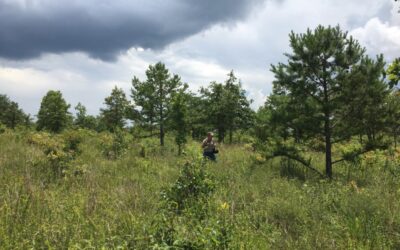The following is a classic David and Goliath story, adapted from Dr. Marge Davis’ book Sportsmen United: The Story of the Tennessee Conservation League. It remains one of the greatest grassroots victories in the history of the American conservation movement.
As part owners in two hunting clubs on the Obion River of West Tennessee, four men—J. Clark Akers III, Bill Dillon, Dr. John Tudor, and Dr. Sam Harwell—together laid claim to about 1,350 acres of wild timber and pin oak flats in the river’s basin—a “duck hunter’s paradise.”
A section of the river that flowed through their property had been channelized, and was scheduled for more dredging. Years earlier, a massive log jam at the Gooch railroad bridge had flooded thousands of acres of good timber.
To the Corps, the only way to prevent it from happening again was to widen and deepen the man-made channel and abandon the river’s original natural flow.
In 1963, the U.S. Army Corps of Engineers contacted affected landowners, asking them to donate an easement so the project could proceed. Akers refused; so did three others. So the Corps simply condemned the land. Soon, what few trees had not been claimed by the flood were felled by machines; the river became a broad, muddy ditch. The project lowered the river channel by thirty feet; all the feeder creeks eroded down to the level of the main stream. Neighboring farmers “cleared every remaining tree and bush up to the banks and converted as many acres of timber as they could burn into bean fields.”
Almost overnight, the duck hunter’s paradise had become a nightmare. For the next six years, no more work was done in Akers’ area. But in 1969, he learned that the Corps had let a new contract that would extend the ditch into Weakley County—and into some of the best remaining duck habitat in the basin.
Akers decided to pay a visit to the Corps engineers. Given the disaster in 1963, he said, shouldn’t you guys at least study the effects of what you’ve done so far, before you do any more?
The Long, Slow Road of Litigation
The environmental impact statement we know today did not come into official existence until New Year’s Day 1970, when President Richard Nixon signed into law the National Environmental Policy Act, which required any “major federal actions… significantly affecting the quality of the human environment” to first prepare a detailed statement of impact, including a list of alternatives. Moreover, since the NEPA could apply to projects started before 1970, the new law could—and eventually would—be applied to the work affecting West Tennessee tributaries.
In April of 1970, Akers and his three fellow duck hunters sued the Secretary of the Army in U.S. District Court in Nashville. By every measure, it was a remarkable action. Suits brought by private individuals against giant government bureaucracies are fairly common nowadays, but not so in 1970.
The idea that four duck hunters could overturn a massive federal project was preposterous, unthinkable, un-American.
In West Tennessee, whole towns sided with the Corps; Eighth District Congressman Ed Jones declared the drainage project “essential to the health and well-being” of every citizen. An editorial in the Dyersburg Mirror railed against wealthy sportsmen who “[sat] comfortably in their plush offices” in Nashville while Dyer County farmers braced for the next season of floods.
Ironically, the floods were worse now than ever, but that was beside the point. “[I]t may have been a big mistake to have started the dredging years ago,” conceded Henry Pierce, an outspoken landowner from Dyersburg, “but now that they have [started], they just can’t leave us here to drown in a half- finished job.”
Akers must have been brave, but he wasn’t foolhardy. He and his partners knew that most judges would take a dim view of four people claiming to represent the conservation interests of the entire state. That was why they hired Charles H. Warfield, “one of the best courtroom lawyers in the state,” according to then-Tennessee Conservation League President Tony Campbell, and partly why the four men organized under the impressive-sounding name of the “National Ecological Foundation.” It was also why they sought the support of the League (now the Tennessee Wildlife Federation).
The Corps, The Court and the Plaintiffs
In January 1971, Tennessee Conservation League petitioned to enter the lawsuit as co-plaintiff, along with its much bigger brother, the National Wildlife Federation. The Sierra Club and the International Association of Game, Fish and Wildlife Commissioners intervened as friends of the court.
NWF and the League retained Charles Newman, a Memphis attorney who was already gaining some experience with NEPA. Newman was the plaintiffs’ attorney on a high-profile case centering on the planned routing of Interstate 40 through Overton Park in Memphis.
At any rate, the League was fortunate to have a good Memphis lawyer: at the Corps’ request, Akers v. Resor had been moved from Nashville to Memphis. Thanks to the inevitable delays, continuances, hearings, injunctions and general quibblings, however, it would not actually go to trial until April 1972. In the meantime, the Corps was enjoined from doing further work in the basin while it prepared a mitigation plan. Its first proposal, offered for public review in early 1971, offered to give the state 14,400 acres of wetlands, including 9,000 acres next to the Gooch and Tigrett WMAs, in compensation for the wetlands it had destroyed.
At about this time (early 1972), the U.S. Attorney in this case, Thomas Turley, reminded the court that, under the Flood Control Act of 1936, the Corps of Engineers must have a local sponsoring agency to maintain the channels once they were cleared. Governor Buford Ellington had volunteered the state of Tennessee to be the sponsoring agency back around 1960 when the channelization first began. The Highway Department was put in charge of the maintenance work, event though “they didn’t have so much as a canoe,” as Clark Akers put it. In 1970, however, the General Assembly failed to make its usual appropriation for the channel work; no one seems to know exactly why.
As a result, in 1972, the state created an all-new sponsoring agency, the Obion-Forked Deer River Basin Authority, to work with the Corps and generally “develop” the water and land resources in the basin.
When at last the case went to trial, testimony lasted little more than a week, most of it not very flattering to the Corps. Expert witnesses testified how up to 95 percent of fish and wildlife habitat was at risk from channelization; how farmers were already getting government subsidies not to farm in the floodplain; even how the basin would in all likelihood continue to flood even after the project was finished. In fact, after pointed questioning, the head of the Dyer County Levee and Drainage District acknowledged that the channelization upstream of Obion County would almost certainly make things worse for the folks in his county.
In May, Judge Bailey Brown delivered his ruling. The environmental impact statement was inadequate, he said. Until the Corps’ engineers could come up with a better one, they would have to sit tight on their West Tennessee Tributaries Project.
For the next several years the ball went back and forth between the Corps, the courts and the plaintiffs. First, the Corps appealed Judge Brown’s injunction, but in 1973, they reached a settlement. Chief among its provisions: 32,000 acres of prime basin wetlands as compensation for the damage already done. In return for the mitigation lands and an acceptable EIS, Akers implied, he and his fellow plaintiffs would settle the lawsuit.
Things seemed to be nearing a resolution; the newspaper even hailed it as such. But in 1976 the plaintiffs realized that the mitigation lands being purchased by the Corps were not in the designated areas. Back to court they went. Meanwhile, the Corps presented its revised EIS, two thousand pages worth of data, studies and comments.
Judge Brown held another hearing to consider its merits, and ruled for a second time that it was inadequate, the only time since its inception that an EIS had been rejected twice. The judge renewed his injunction against further digging, and again ordered the Corps to produce an acceptable impact statement.
The final Consent Agreement was signed by all parties in May 1985, and it stated that the Corps must mitigate for current damages by purchasing 32,000 acres of wetlands. Eventually, the Corps would purchase just over 14,000 acres of wetlands before shutting the West Tennessee Tributaries Project down.
In the End, Mother Nature Has the Final Say
The 1980 National Wildlife Federation Convention in Miami was a seminal moment for the League. The League itself was honored with a “Connie” Award for legislative work, and longtime Tennessee Conservation League supporter Clark Akers won a whooping crane statuette in honor of his decade-long fight to preserve the Obion-Forked Deer watershed.
The League’s win—its first since 1954—was gratifying proof of the progress it had made in the decade just ended. Akers’ award, on the other hand, was a promising omen for the years to come.
This man, this David who had successfully challenged a government Goliath, would come to be seen as a metaphor of ‘80s activism, a symbol of the growing clout and stamina of the citizen conservation lobby.
It was a tall order, taking on the Corps and their $30 million project, but Akers was in a position to fight it. He was a civil engineer by training, and had done well enough in business to have the time and resources.
“A lot of people eventually woke up to the fact that what the Corps was telling them wasn’t the truth, that their land wasn’t going to flood anymore,” Akers says. “You can dig a 300-foot wide ditch, but if you drain all the oxbows and grade the low spots, there’s nowhere for that water to go.”
Locals were excited by the prospect of more land to farm, and less enthused about landowners from another part of the state messing with their prospectus. The local paper ran a cartoon of the “Nashville Four” as one great big hand pushing a bunch of farmers down into the mud.
“They hadn’t been digging for several years, but here they were again,” he says. “I managed to get an environmental injunction and went to see the Colonel. I asked him to at least look at the environmental impact first, and he told me nothing could stop them.”
Even after the 1985 settlement, the legal maneuvering continued. The Obion-Forked Deer River Basin Authority tried to revive the channelization project as a state surrogate for the Corps of Engineers, and the Conservation League and Akers’ National Ecological Foundation sued the state and then-Gov. Lamar Alexander to stop it. The courts ruled that the River Authority was in violation of the agreed-to order, issued yet another injunction, and eventually a second settlement was reached.
In 1996, Gov. Ned McWherter formed the West Tennessee Tributaries Task Force in response to a group of farmers still trying to find a way to reactivate the project. McWherter was trying to find a solution, but the state’s official policy eventually became “no channelization.”
Fifteen years later, it was a procedural stalemate. Akers sums it up aptly, and is victorious in the knowledge that Mother Nature will have the final say.
“You have righteous people arguing for the natural river on one side and farmers arguing for flood control on the other,” he says.
“We in the middle say that channelization clearly doesn’t work, and the damage is not worth the cost—these rivers are going to revert to meanders over decades anyway, so why not just leave them alone?”
Clark Akers




